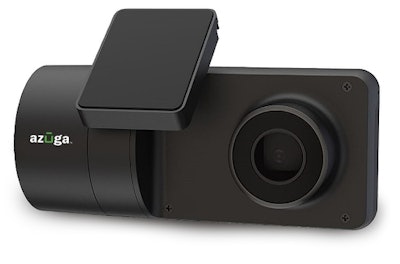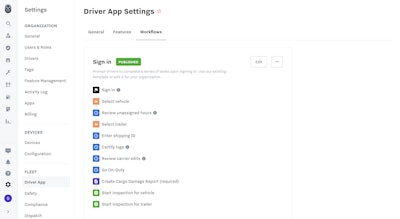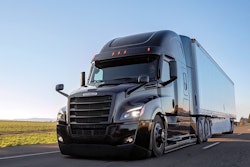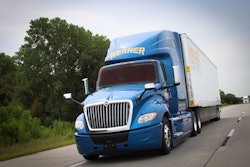Advancements by fleet management technology suppliers in the realm of Internet of Things (IoT) are following a predictable path. They are developing more powerful mobile devices and sensors in vehicles using cameras and algorithms fueled by artificial intelligence to give fleet managers and drivers instant visibility into risky behaviors and other problem areas.
Real-time driver monitoring
 The Azuga SafetyCam AI has new driver monitoring features to detect fatigued and distracted behaviors.
The Azuga SafetyCam AI has new driver monitoring features to detect fatigued and distracted behaviors.Azuga, a fleet telematics company, recently added facial recognition and other enhancement to its fleet dashcam, Azuga SafetyCam AI, that uses a combination of multi-sensor HD cameras, artificial intelligence and computer vision technology.
The facial recognition technology detects when a driver is distracted or drowsy at night or during the day. The dashcam also produces a live stream of the driver while alerting fleet managers to potentially dangerous activity, such as hard braking, sharp turns, distracted driving and rapid acceleration.
Azuga has an optional premium service where risk analysts tag and prioritize the events that illustrate risky driving behavior for coaching.
“We were reducing accidents by 38% without dashcams and expect to cut accidents by half or more as more fleets adopt this technology,” said Azuga Chief Executive Ananth Rani.
Azuga Fleet is currently monitoring more than 200,000 vehicles on roads across North America.
AI computer vision in-cabin automotive solutions provider Cipia, formerly Eyesight Technologies, has made its Fleet Sense driver monitoring (DMS) device available for fleets.
 Cipia has made its driver monitoring system available for fleets and telematics service providers.
Cipia has made its driver monitoring system available for fleets and telematics service providers.The DMS device and software gives drivers real-time alerts when drowsiness, distraction or dangerous actions are detected to mitigate resulting accidents. Fleet managers also receive real-time event alerts according to their needs.
Fleet Sense also provides data to support analytics efforts by telematics service providers and fleet managers. The data can assist with identifying drivers, workforce management enhancement and information to support driver scoring and training systems.
Customizing the user experience
Despite the added complexity of IoT technology, the user experience is being simplified by new developments that aim to sharpen the focus of drivers and fleet managers on the areas they can directly and immediately control.
One of the new developments that aims to improve the user experience comes from Samsara. The company added new tools to its Samsara Driver App — the user interface of its ELD and mobility platform — that make it easy for fleets to customize driver workflow.
Workflow Builder allows fleets to customize and instantly publish guided workflows to help drivers minimize guesswork and comply with fleet policies. The tool has a drag-and-drop interface to visualize and select tasks for drivers to complete and in what order.
Fleets can define start-of-day workflows, such as having drivers review their hours of service, perform pre-trip inspections, check inventory or complete a customized form by the fleet.
App Designer allows managers to control which features are available in the Driver App and configure the behavior of those features.
Western Concrete Pumping (WCP), a Samsara customer and one of the nation’s largest concrete pumping companies with service across seven states, is planning to use Workflow Builder to improve the start-of-day process, such as pre- and post-trip vehicle inspections, for more than 160 drivers.
 Workflow Builder from Samara simplifies the process for fleets to customize the driver workflow.
Workflow Builder from Samara simplifies the process for fleets to customize the driver workflow.“Before COVID-19, we used to travel to each branch office and train operators in person,” said Carol Heinz, WCP’s fleet administrative assistant. “With Workflow Builder, we can be more confident that our drivers are completing the right tasks in the right sequence, even now that we’re working remote.”
The connected office
New advancements in IoT are not very advantageous to fleets unless they have office systems to support the variety of data coming from various sources. Transportation management software suppliers are tasked with integrating new features into their systems. This is more easily done by cloud-based platforms.
Axele has made several upgrades to its cloud-based platform designed for small and midsized truckload carriers to expand connectivity. Among the major upgrades in the latest version are:
- QuickBooks Integration to streamline invoice creation and data entry.
- Advanced Dispatch Module to split loads into legs, assign them to separate drivers, and create invoice records for each leg to pay drivers while generating a consolidated customer invoice.
- ELD integrations with EROAD, 3MD ELD, and LB Technology. The integrations enable predictive ETAs, hours of service information for driver scheduling, and improved location tracking.
- Push notifications on Axele’s mobile app help drivers focus on the road and still be aware of new load assignments, cancellations and other real-time updates.
- Document scanning enhancement on the mobile app supports higher resolution images, page edge detection, image rotation, multi-page documents, and automatic color/resolution optimization.
“As we’ve added capabilities, we have always maintained keeping Axele user-friendly as a top priority,” said Ravi Ahuja, founder and chief executive of Axele.













